Context of Business: A Detailed Analysis of Sainsbury's Performance
VerifiedAdded on 2020/11/23
|9
|2530
|360
Project
AI Summary
This project provides a comprehensive analysis of Sainsbury's, a major player in the retail sector. It begins with a historical overview of the company, tracing its evolution from its founding in 1869 to its current status, highlighting key milestones and challenges. The assignment then delves into Sainsbury's vision, leadership styles (specifically autocratic leadership), and management practices, including training, performance management, and innovation. It explores the company's strategies, such as providing quality products at competitive prices. The analysis further examines the implementation and achievement of these elements, followed by recommendations for improvement, particularly suggesting a shift towards a more democratic leadership style. The project concludes with a summary of the key findings and insights into Sainsbury's business context, strategy, and management approaches.

Context of business
(Project - 2)
(Project - 2)
Paraphrase This Document
Need a fresh take? Get an instant paraphrase of this document with our AI Paraphraser
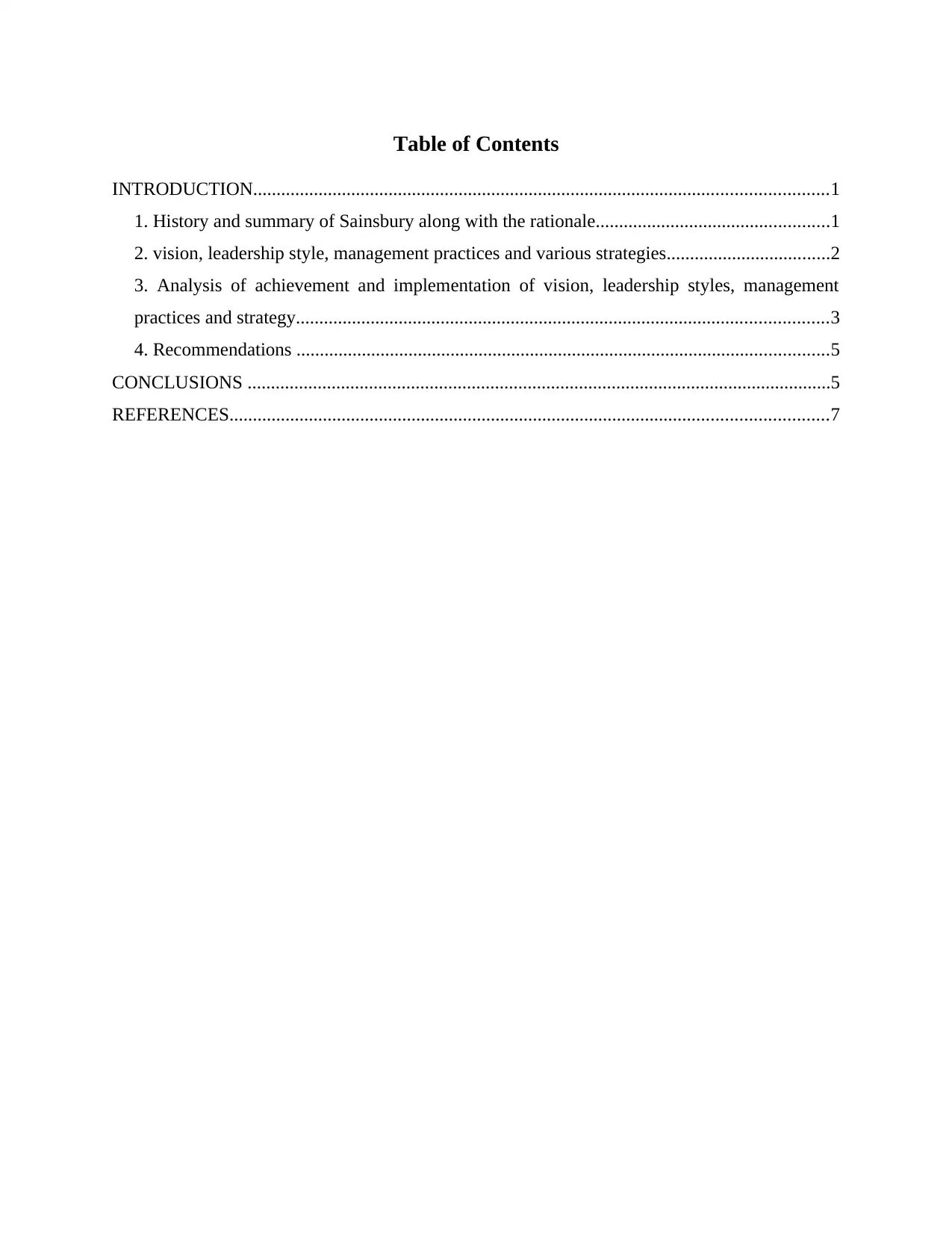
Table of Contents
INTRODUCTION...........................................................................................................................1
1. History and summary of Sainsbury along with the rationale..................................................1
2. vision, leadership style, management practices and various strategies...................................2
3. Analysis of achievement and implementation of vision, leadership styles, management
practices and strategy..................................................................................................................3
4. Recommendations ..................................................................................................................5
CONCLUSIONS .............................................................................................................................5
REFERENCES................................................................................................................................7
INTRODUCTION...........................................................................................................................1
1. History and summary of Sainsbury along with the rationale..................................................1
2. vision, leadership style, management practices and various strategies...................................2
3. Analysis of achievement and implementation of vision, leadership styles, management
practices and strategy..................................................................................................................3
4. Recommendations ..................................................................................................................5
CONCLUSIONS .............................................................................................................................5
REFERENCES................................................................................................................................7
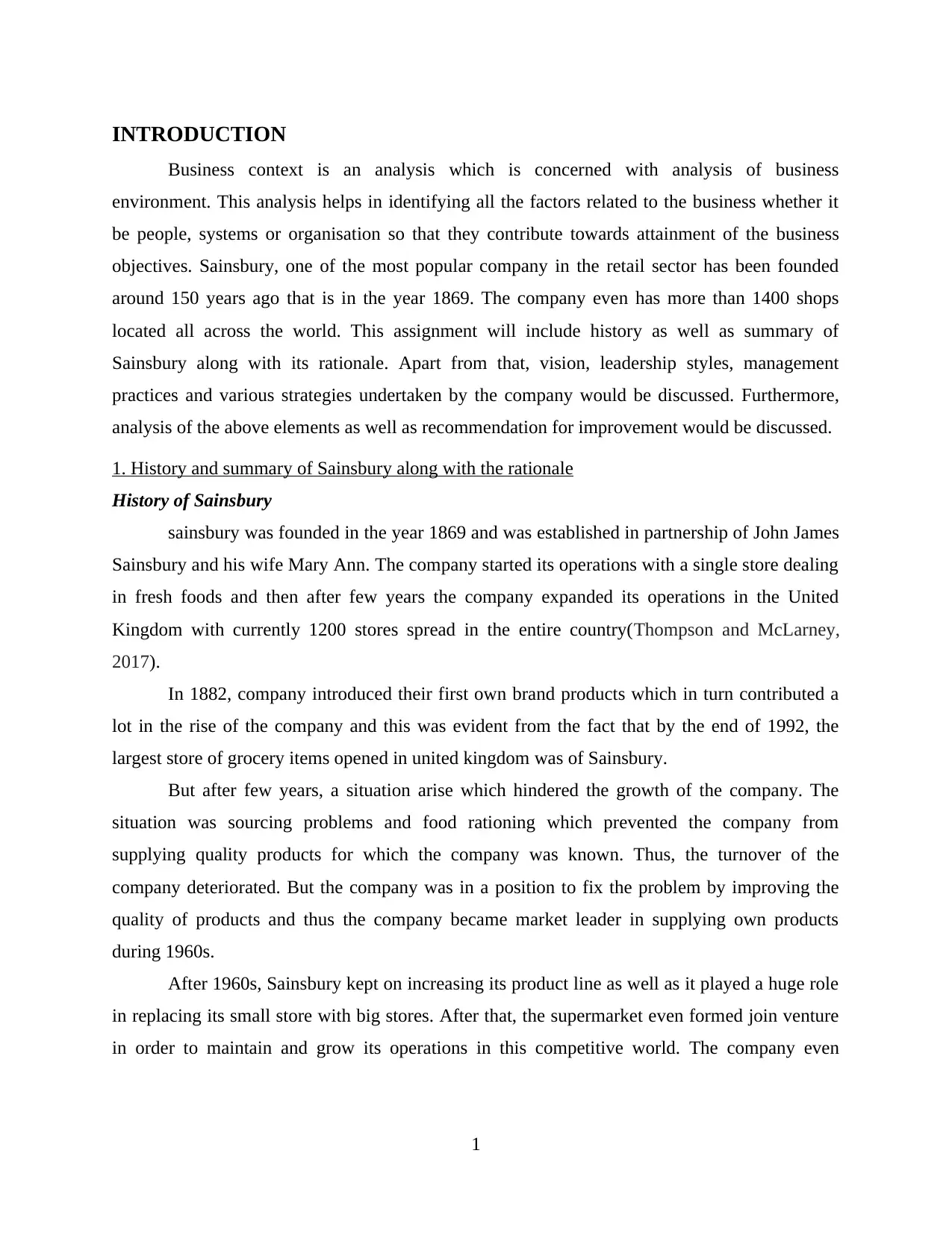
INTRODUCTION
Business context is an analysis which is concerned with analysis of business
environment. This analysis helps in identifying all the factors related to the business whether it
be people, systems or organisation so that they contribute towards attainment of the business
objectives. Sainsbury, one of the most popular company in the retail sector has been founded
around 150 years ago that is in the year 1869. The company even has more than 1400 shops
located all across the world. This assignment will include history as well as summary of
Sainsbury along with its rationale. Apart from that, vision, leadership styles, management
practices and various strategies undertaken by the company would be discussed. Furthermore,
analysis of the above elements as well as recommendation for improvement would be discussed.
1. History and summary of Sainsbury along with the rationale
History of Sainsbury
sainsbury was founded in the year 1869 and was established in partnership of John James
Sainsbury and his wife Mary Ann. The company started its operations with a single store dealing
in fresh foods and then after few years the company expanded its operations in the United
Kingdom with currently 1200 stores spread in the entire country(Thompson and McLarney,
2017).
In 1882, company introduced their first own brand products which in turn contributed a
lot in the rise of the company and this was evident from the fact that by the end of 1992, the
largest store of grocery items opened in united kingdom was of Sainsbury.
But after few years, a situation arise which hindered the growth of the company. The
situation was sourcing problems and food rationing which prevented the company from
supplying quality products for which the company was known. Thus, the turnover of the
company deteriorated. But the company was in a position to fix the problem by improving the
quality of products and thus the company became market leader in supplying own products
during 1960s.
After 1960s, Sainsbury kept on increasing its product line as well as it played a huge role
in replacing its small store with big stores. After that, the supermarket even formed join venture
in order to maintain and grow its operations in this competitive world. The company even
1
Business context is an analysis which is concerned with analysis of business
environment. This analysis helps in identifying all the factors related to the business whether it
be people, systems or organisation so that they contribute towards attainment of the business
objectives. Sainsbury, one of the most popular company in the retail sector has been founded
around 150 years ago that is in the year 1869. The company even has more than 1400 shops
located all across the world. This assignment will include history as well as summary of
Sainsbury along with its rationale. Apart from that, vision, leadership styles, management
practices and various strategies undertaken by the company would be discussed. Furthermore,
analysis of the above elements as well as recommendation for improvement would be discussed.
1. History and summary of Sainsbury along with the rationale
History of Sainsbury
sainsbury was founded in the year 1869 and was established in partnership of John James
Sainsbury and his wife Mary Ann. The company started its operations with a single store dealing
in fresh foods and then after few years the company expanded its operations in the United
Kingdom with currently 1200 stores spread in the entire country(Thompson and McLarney,
2017).
In 1882, company introduced their first own brand products which in turn contributed a
lot in the rise of the company and this was evident from the fact that by the end of 1992, the
largest store of grocery items opened in united kingdom was of Sainsbury.
But after few years, a situation arise which hindered the growth of the company. The
situation was sourcing problems and food rationing which prevented the company from
supplying quality products for which the company was known. Thus, the turnover of the
company deteriorated. But the company was in a position to fix the problem by improving the
quality of products and thus the company became market leader in supplying own products
during 1960s.
After 1960s, Sainsbury kept on increasing its product line as well as it played a huge role
in replacing its small store with big stores. After that, the supermarket even formed join venture
in order to maintain and grow its operations in this competitive world. The company even
1
⊘ This is a preview!⊘
Do you want full access?
Subscribe today to unlock all pages.

Trusted by 1+ million students worldwide
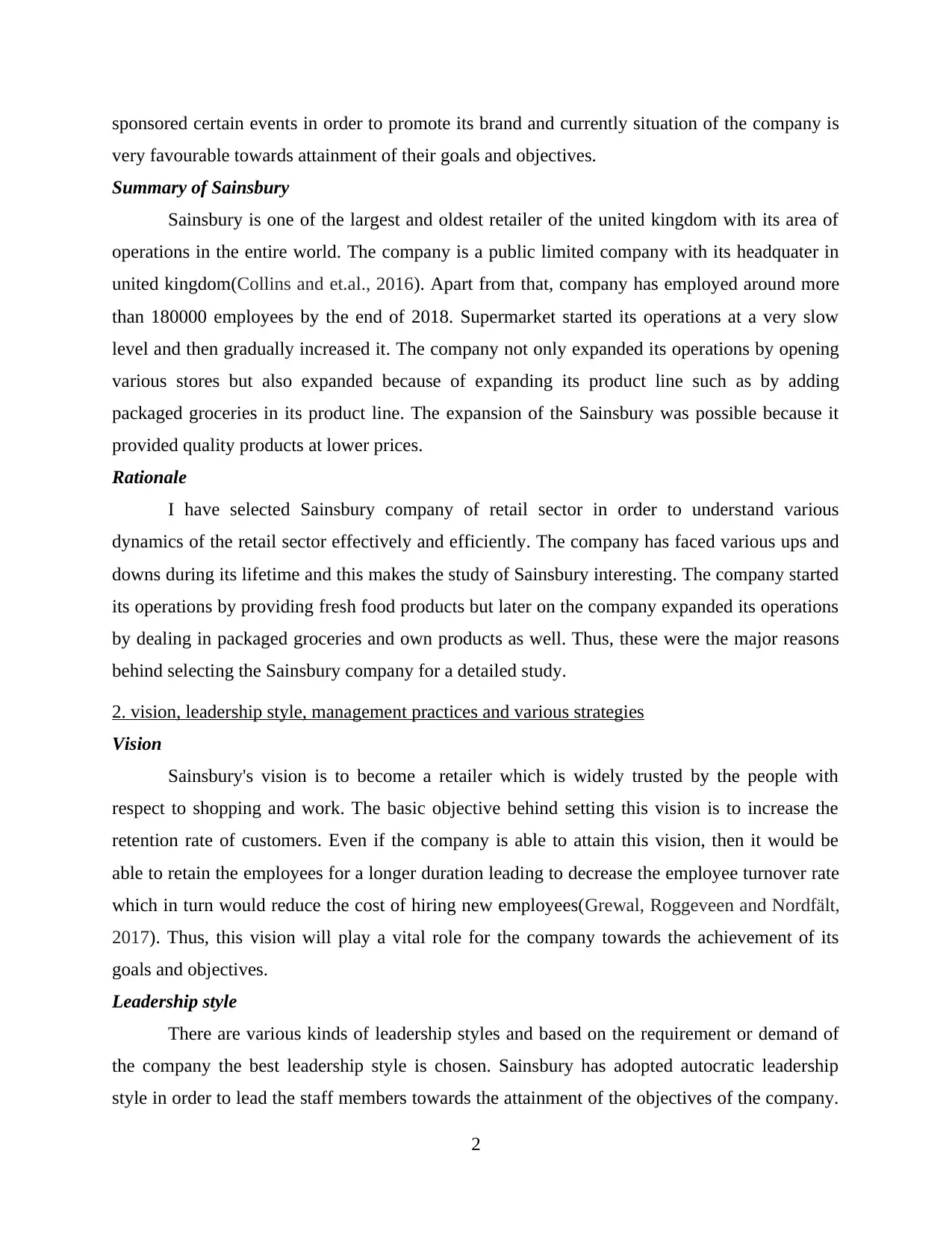
sponsored certain events in order to promote its brand and currently situation of the company is
very favourable towards attainment of their goals and objectives.
Summary of Sainsbury
Sainsbury is one of the largest and oldest retailer of the united kingdom with its area of
operations in the entire world. The company is a public limited company with its headquater in
united kingdom(Collins and et.al., 2016). Apart from that, company has employed around more
than 180000 employees by the end of 2018. Supermarket started its operations at a very slow
level and then gradually increased it. The company not only expanded its operations by opening
various stores but also expanded because of expanding its product line such as by adding
packaged groceries in its product line. The expansion of the Sainsbury was possible because it
provided quality products at lower prices.
Rationale
I have selected Sainsbury company of retail sector in order to understand various
dynamics of the retail sector effectively and efficiently. The company has faced various ups and
downs during its lifetime and this makes the study of Sainsbury interesting. The company started
its operations by providing fresh food products but later on the company expanded its operations
by dealing in packaged groceries and own products as well. Thus, these were the major reasons
behind selecting the Sainsbury company for a detailed study.
2. vision, leadership style, management practices and various strategies
Vision
Sainsbury's vision is to become a retailer which is widely trusted by the people with
respect to shopping and work. The basic objective behind setting this vision is to increase the
retention rate of customers. Even if the company is able to attain this vision, then it would be
able to retain the employees for a longer duration leading to decrease the employee turnover rate
which in turn would reduce the cost of hiring new employees(Grewal, Roggeveen and Nordfält,
2017). Thus, this vision will play a vital role for the company towards the achievement of its
goals and objectives.
Leadership style
There are various kinds of leadership styles and based on the requirement or demand of
the company the best leadership style is chosen. Sainsbury has adopted autocratic leadership
style in order to lead the staff members towards the attainment of the objectives of the company.
2
very favourable towards attainment of their goals and objectives.
Summary of Sainsbury
Sainsbury is one of the largest and oldest retailer of the united kingdom with its area of
operations in the entire world. The company is a public limited company with its headquater in
united kingdom(Collins and et.al., 2016). Apart from that, company has employed around more
than 180000 employees by the end of 2018. Supermarket started its operations at a very slow
level and then gradually increased it. The company not only expanded its operations by opening
various stores but also expanded because of expanding its product line such as by adding
packaged groceries in its product line. The expansion of the Sainsbury was possible because it
provided quality products at lower prices.
Rationale
I have selected Sainsbury company of retail sector in order to understand various
dynamics of the retail sector effectively and efficiently. The company has faced various ups and
downs during its lifetime and this makes the study of Sainsbury interesting. The company started
its operations by providing fresh food products but later on the company expanded its operations
by dealing in packaged groceries and own products as well. Thus, these were the major reasons
behind selecting the Sainsbury company for a detailed study.
2. vision, leadership style, management practices and various strategies
Vision
Sainsbury's vision is to become a retailer which is widely trusted by the people with
respect to shopping and work. The basic objective behind setting this vision is to increase the
retention rate of customers. Even if the company is able to attain this vision, then it would be
able to retain the employees for a longer duration leading to decrease the employee turnover rate
which in turn would reduce the cost of hiring new employees(Grewal, Roggeveen and Nordfält,
2017). Thus, this vision will play a vital role for the company towards the achievement of its
goals and objectives.
Leadership style
There are various kinds of leadership styles and based on the requirement or demand of
the company the best leadership style is chosen. Sainsbury has adopted autocratic leadership
style in order to lead the staff members towards the attainment of the objectives of the company.
2
Paraphrase This Document
Need a fresh take? Get an instant paraphrase of this document with our AI Paraphraser
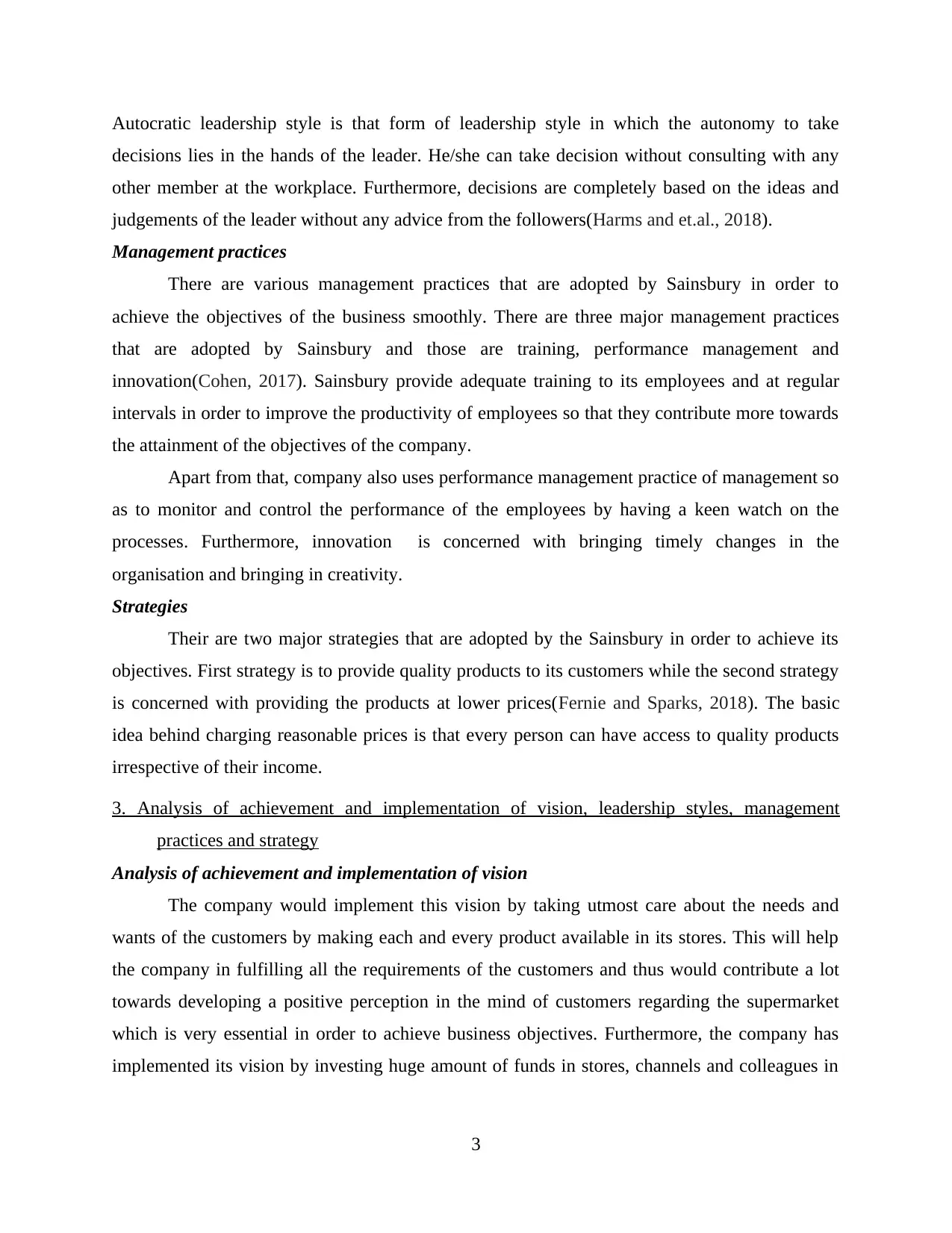
Autocratic leadership style is that form of leadership style in which the autonomy to take
decisions lies in the hands of the leader. He/she can take decision without consulting with any
other member at the workplace. Furthermore, decisions are completely based on the ideas and
judgements of the leader without any advice from the followers(Harms and et.al., 2018).
Management practices
There are various management practices that are adopted by Sainsbury in order to
achieve the objectives of the business smoothly. There are three major management practices
that are adopted by Sainsbury and those are training, performance management and
innovation(Cohen, 2017). Sainsbury provide adequate training to its employees and at regular
intervals in order to improve the productivity of employees so that they contribute more towards
the attainment of the objectives of the company.
Apart from that, company also uses performance management practice of management so
as to monitor and control the performance of the employees by having a keen watch on the
processes. Furthermore, innovation is concerned with bringing timely changes in the
organisation and bringing in creativity.
Strategies
Their are two major strategies that are adopted by the Sainsbury in order to achieve its
objectives. First strategy is to provide quality products to its customers while the second strategy
is concerned with providing the products at lower prices(Fernie and Sparks, 2018). The basic
idea behind charging reasonable prices is that every person can have access to quality products
irrespective of their income.
3. Analysis of achievement and implementation of vision, leadership styles, management
practices and strategy
Analysis of achievement and implementation of vision
The company would implement this vision by taking utmost care about the needs and
wants of the customers by making each and every product available in its stores. This will help
the company in fulfilling all the requirements of the customers and thus would contribute a lot
towards developing a positive perception in the mind of customers regarding the supermarket
which is very essential in order to achieve business objectives. Furthermore, the company has
implemented its vision by investing huge amount of funds in stores, channels and colleagues in
3
decisions lies in the hands of the leader. He/she can take decision without consulting with any
other member at the workplace. Furthermore, decisions are completely based on the ideas and
judgements of the leader without any advice from the followers(Harms and et.al., 2018).
Management practices
There are various management practices that are adopted by Sainsbury in order to
achieve the objectives of the business smoothly. There are three major management practices
that are adopted by Sainsbury and those are training, performance management and
innovation(Cohen, 2017). Sainsbury provide adequate training to its employees and at regular
intervals in order to improve the productivity of employees so that they contribute more towards
the attainment of the objectives of the company.
Apart from that, company also uses performance management practice of management so
as to monitor and control the performance of the employees by having a keen watch on the
processes. Furthermore, innovation is concerned with bringing timely changes in the
organisation and bringing in creativity.
Strategies
Their are two major strategies that are adopted by the Sainsbury in order to achieve its
objectives. First strategy is to provide quality products to its customers while the second strategy
is concerned with providing the products at lower prices(Fernie and Sparks, 2018). The basic
idea behind charging reasonable prices is that every person can have access to quality products
irrespective of their income.
3. Analysis of achievement and implementation of vision, leadership styles, management
practices and strategy
Analysis of achievement and implementation of vision
The company would implement this vision by taking utmost care about the needs and
wants of the customers by making each and every product available in its stores. This will help
the company in fulfilling all the requirements of the customers and thus would contribute a lot
towards developing a positive perception in the mind of customers regarding the supermarket
which is very essential in order to achieve business objectives. Furthermore, the company has
implemented its vision by investing huge amount of funds in stores, channels and colleagues in
3
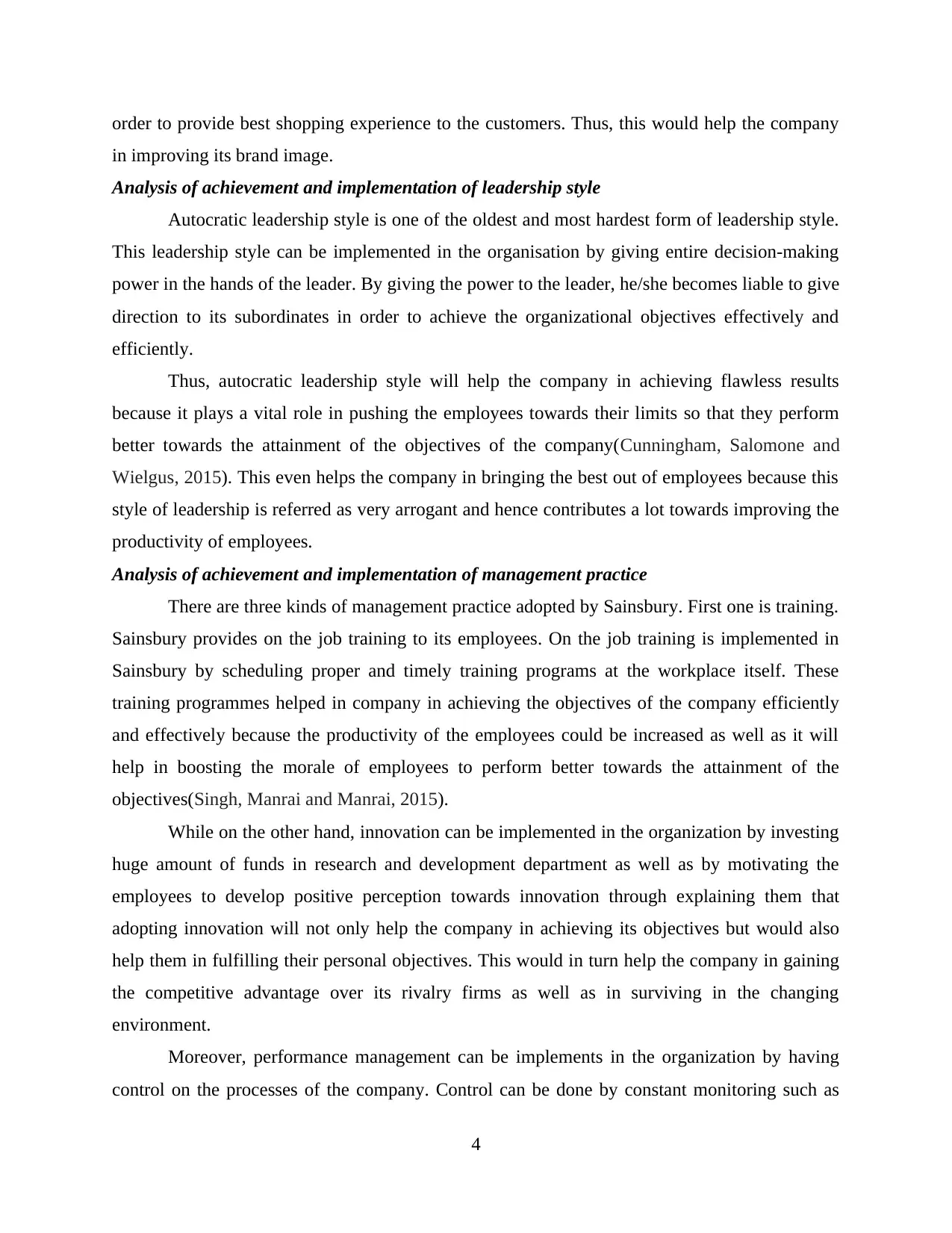
order to provide best shopping experience to the customers. Thus, this would help the company
in improving its brand image.
Analysis of achievement and implementation of leadership style
Autocratic leadership style is one of the oldest and most hardest form of leadership style.
This leadership style can be implemented in the organisation by giving entire decision-making
power in the hands of the leader. By giving the power to the leader, he/she becomes liable to give
direction to its subordinates in order to achieve the organizational objectives effectively and
efficiently.
Thus, autocratic leadership style will help the company in achieving flawless results
because it plays a vital role in pushing the employees towards their limits so that they perform
better towards the attainment of the objectives of the company(Cunningham, Salomone and
Wielgus, 2015). This even helps the company in bringing the best out of employees because this
style of leadership is referred as very arrogant and hence contributes a lot towards improving the
productivity of employees.
Analysis of achievement and implementation of management practice
There are three kinds of management practice adopted by Sainsbury. First one is training.
Sainsbury provides on the job training to its employees. On the job training is implemented in
Sainsbury by scheduling proper and timely training programs at the workplace itself. These
training programmes helped in company in achieving the objectives of the company efficiently
and effectively because the productivity of the employees could be increased as well as it will
help in boosting the morale of employees to perform better towards the attainment of the
objectives(Singh, Manrai and Manrai, 2015).
While on the other hand, innovation can be implemented in the organization by investing
huge amount of funds in research and development department as well as by motivating the
employees to develop positive perception towards innovation through explaining them that
adopting innovation will not only help the company in achieving its objectives but would also
help them in fulfilling their personal objectives. This would in turn help the company in gaining
the competitive advantage over its rivalry firms as well as in surviving in the changing
environment.
Moreover, performance management can be implements in the organization by having
control on the processes of the company. Control can be done by constant monitoring such as
4
in improving its brand image.
Analysis of achievement and implementation of leadership style
Autocratic leadership style is one of the oldest and most hardest form of leadership style.
This leadership style can be implemented in the organisation by giving entire decision-making
power in the hands of the leader. By giving the power to the leader, he/she becomes liable to give
direction to its subordinates in order to achieve the organizational objectives effectively and
efficiently.
Thus, autocratic leadership style will help the company in achieving flawless results
because it plays a vital role in pushing the employees towards their limits so that they perform
better towards the attainment of the objectives of the company(Cunningham, Salomone and
Wielgus, 2015). This even helps the company in bringing the best out of employees because this
style of leadership is referred as very arrogant and hence contributes a lot towards improving the
productivity of employees.
Analysis of achievement and implementation of management practice
There are three kinds of management practice adopted by Sainsbury. First one is training.
Sainsbury provides on the job training to its employees. On the job training is implemented in
Sainsbury by scheduling proper and timely training programs at the workplace itself. These
training programmes helped in company in achieving the objectives of the company efficiently
and effectively because the productivity of the employees could be increased as well as it will
help in boosting the morale of employees to perform better towards the attainment of the
objectives(Singh, Manrai and Manrai, 2015).
While on the other hand, innovation can be implemented in the organization by investing
huge amount of funds in research and development department as well as by motivating the
employees to develop positive perception towards innovation through explaining them that
adopting innovation will not only help the company in achieving its objectives but would also
help them in fulfilling their personal objectives. This would in turn help the company in gaining
the competitive advantage over its rivalry firms as well as in surviving in the changing
environment.
Moreover, performance management can be implements in the organization by having
control on the processes of the company. Control can be done by constant monitoring such as
4
⊘ This is a preview!⊘
Do you want full access?
Subscribe today to unlock all pages.

Trusted by 1+ million students worldwide
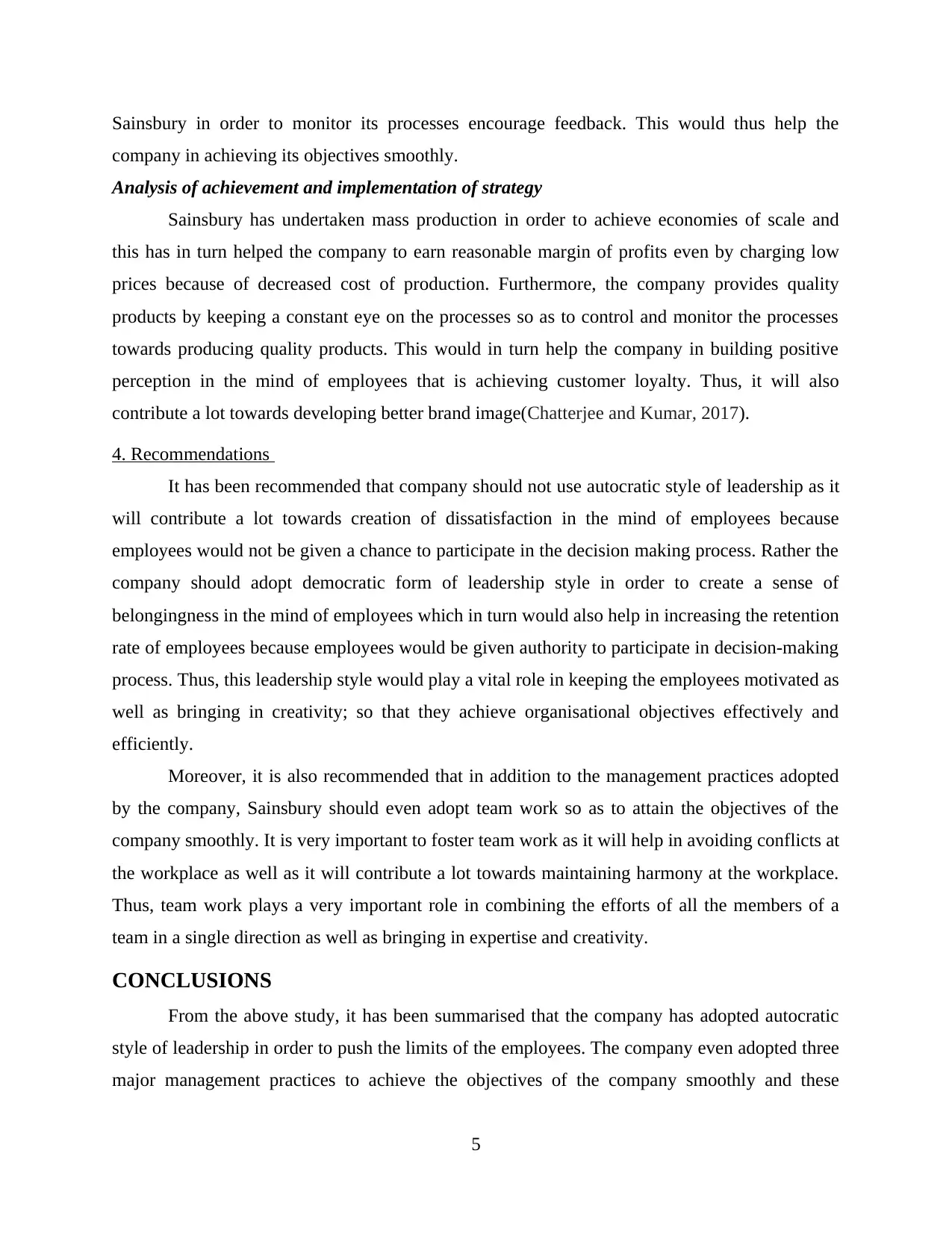
Sainsbury in order to monitor its processes encourage feedback. This would thus help the
company in achieving its objectives smoothly.
Analysis of achievement and implementation of strategy
Sainsbury has undertaken mass production in order to achieve economies of scale and
this has in turn helped the company to earn reasonable margin of profits even by charging low
prices because of decreased cost of production. Furthermore, the company provides quality
products by keeping a constant eye on the processes so as to control and monitor the processes
towards producing quality products. This would in turn help the company in building positive
perception in the mind of employees that is achieving customer loyalty. Thus, it will also
contribute a lot towards developing better brand image(Chatterjee and Kumar, 2017).
4. Recommendations
It has been recommended that company should not use autocratic style of leadership as it
will contribute a lot towards creation of dissatisfaction in the mind of employees because
employees would not be given a chance to participate in the decision making process. Rather the
company should adopt democratic form of leadership style in order to create a sense of
belongingness in the mind of employees which in turn would also help in increasing the retention
rate of employees because employees would be given authority to participate in decision-making
process. Thus, this leadership style would play a vital role in keeping the employees motivated as
well as bringing in creativity; so that they achieve organisational objectives effectively and
efficiently.
Moreover, it is also recommended that in addition to the management practices adopted
by the company, Sainsbury should even adopt team work so as to attain the objectives of the
company smoothly. It is very important to foster team work as it will help in avoiding conflicts at
the workplace as well as it will contribute a lot towards maintaining harmony at the workplace.
Thus, team work plays a very important role in combining the efforts of all the members of a
team in a single direction as well as bringing in expertise and creativity.
CONCLUSIONS
From the above study, it has been summarised that the company has adopted autocratic
style of leadership in order to push the limits of the employees. The company even adopted three
major management practices to achieve the objectives of the company smoothly and these
5
company in achieving its objectives smoothly.
Analysis of achievement and implementation of strategy
Sainsbury has undertaken mass production in order to achieve economies of scale and
this has in turn helped the company to earn reasonable margin of profits even by charging low
prices because of decreased cost of production. Furthermore, the company provides quality
products by keeping a constant eye on the processes so as to control and monitor the processes
towards producing quality products. This would in turn help the company in building positive
perception in the mind of employees that is achieving customer loyalty. Thus, it will also
contribute a lot towards developing better brand image(Chatterjee and Kumar, 2017).
4. Recommendations
It has been recommended that company should not use autocratic style of leadership as it
will contribute a lot towards creation of dissatisfaction in the mind of employees because
employees would not be given a chance to participate in the decision making process. Rather the
company should adopt democratic form of leadership style in order to create a sense of
belongingness in the mind of employees which in turn would also help in increasing the retention
rate of employees because employees would be given authority to participate in decision-making
process. Thus, this leadership style would play a vital role in keeping the employees motivated as
well as bringing in creativity; so that they achieve organisational objectives effectively and
efficiently.
Moreover, it is also recommended that in addition to the management practices adopted
by the company, Sainsbury should even adopt team work so as to attain the objectives of the
company smoothly. It is very important to foster team work as it will help in avoiding conflicts at
the workplace as well as it will contribute a lot towards maintaining harmony at the workplace.
Thus, team work plays a very important role in combining the efforts of all the members of a
team in a single direction as well as bringing in expertise and creativity.
CONCLUSIONS
From the above study, it has been summarised that the company has adopted autocratic
style of leadership in order to push the limits of the employees. The company even adopted three
major management practices to achieve the objectives of the company smoothly and these
5
Paraphrase This Document
Need a fresh take? Get an instant paraphrase of this document with our AI Paraphraser
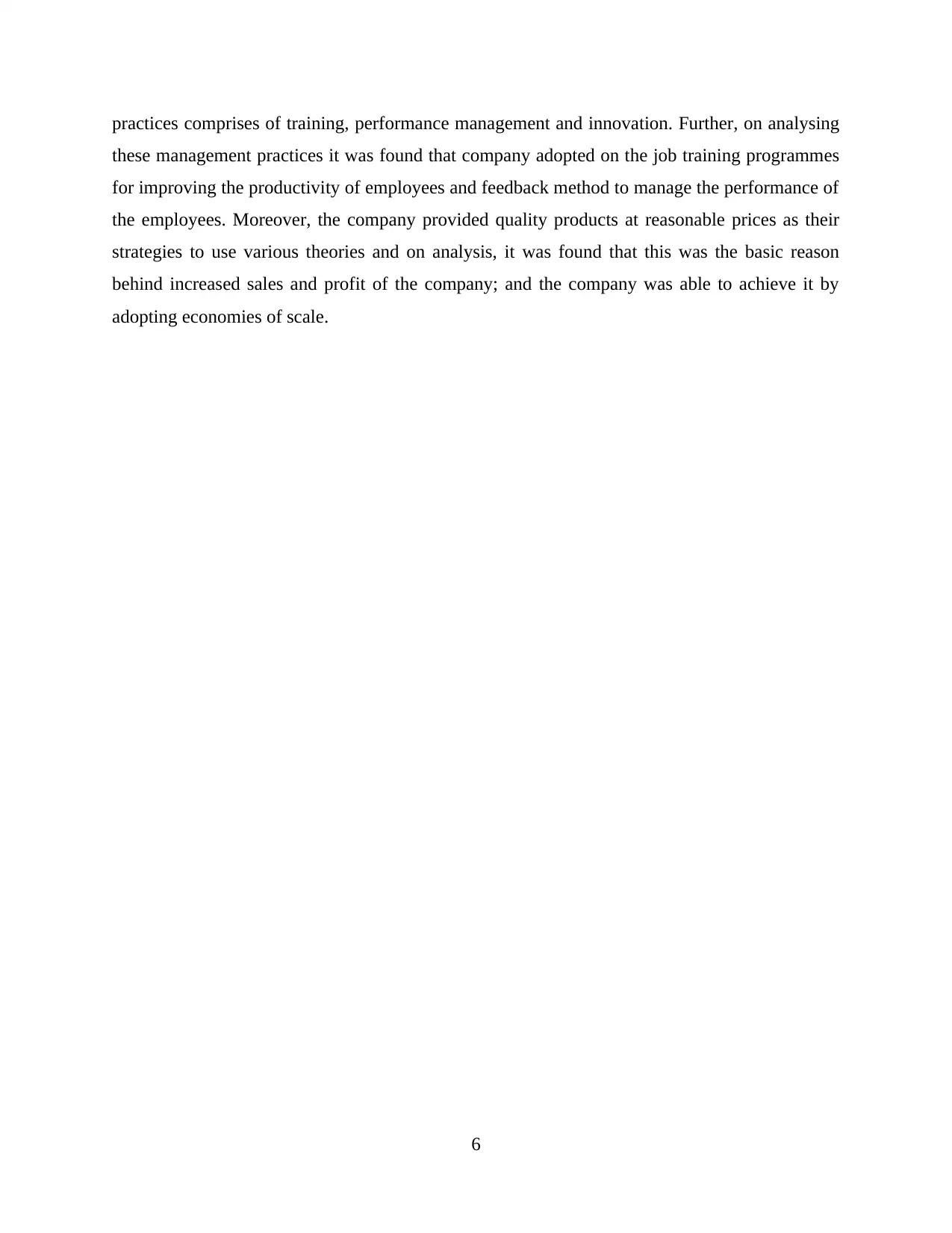
practices comprises of training, performance management and innovation. Further, on analysing
these management practices it was found that company adopted on the job training programmes
for improving the productivity of employees and feedback method to manage the performance of
the employees. Moreover, the company provided quality products at reasonable prices as their
strategies to use various theories and on analysis, it was found that this was the basic reason
behind increased sales and profit of the company; and the company was able to achieve it by
adopting economies of scale.
6
these management practices it was found that company adopted on the job training programmes
for improving the productivity of employees and feedback method to manage the performance of
the employees. Moreover, the company provided quality products at reasonable prices as their
strategies to use various theories and on analysis, it was found that this was the basic reason
behind increased sales and profit of the company; and the company was able to achieve it by
adopting economies of scale.
6
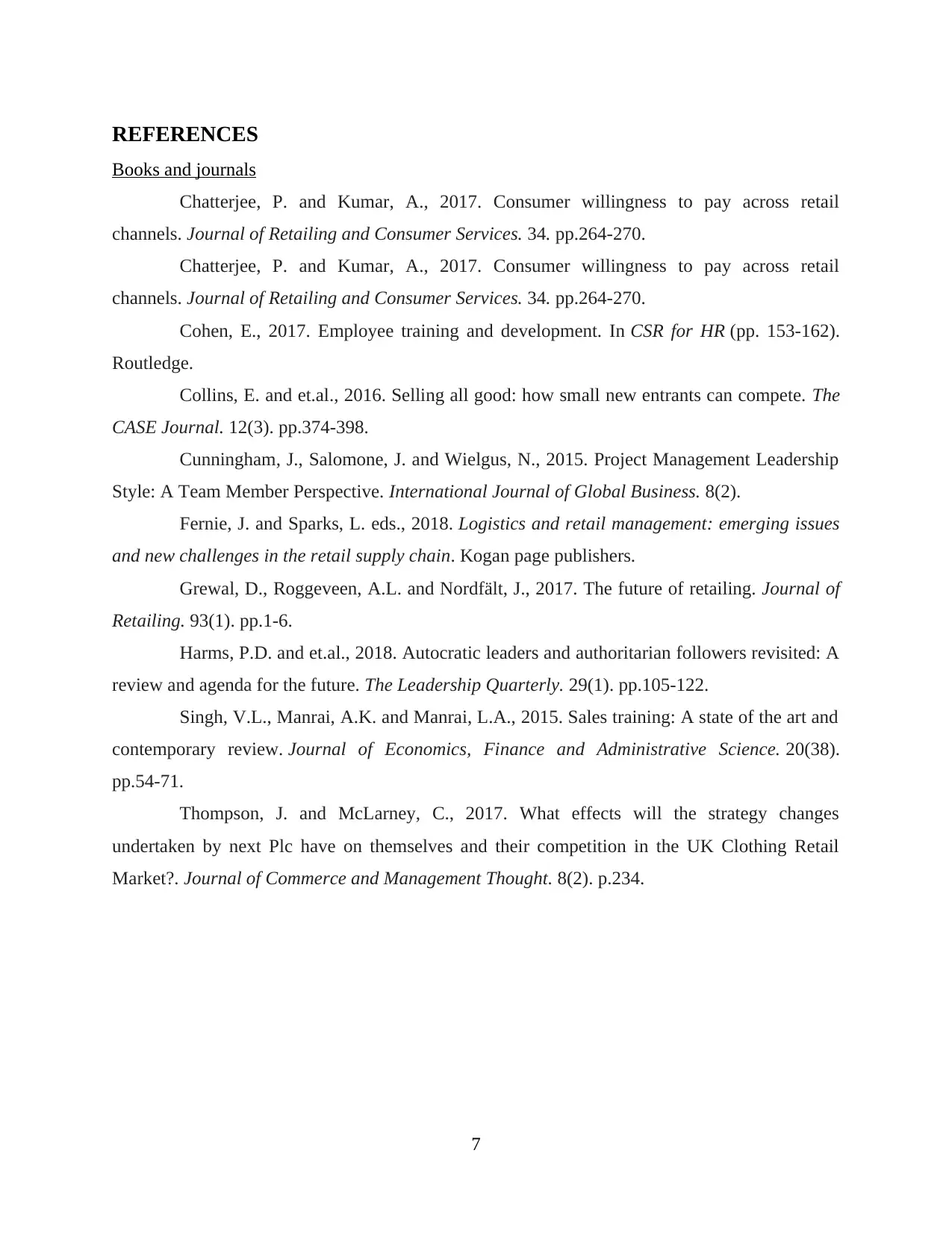
REFERENCES
Books and journals
Chatterjee, P. and Kumar, A., 2017. Consumer willingness to pay across retail
channels. Journal of Retailing and Consumer Services. 34. pp.264-270.
Chatterjee, P. and Kumar, A., 2017. Consumer willingness to pay across retail
channels. Journal of Retailing and Consumer Services. 34. pp.264-270.
Cohen, E., 2017. Employee training and development. In CSR for HR (pp. 153-162).
Routledge.
Collins, E. and et.al., 2016. Selling all good: how small new entrants can compete. The
CASE Journal. 12(3). pp.374-398.
Cunningham, J., Salomone, J. and Wielgus, N., 2015. Project Management Leadership
Style: A Team Member Perspective. International Journal of Global Business. 8(2).
Fernie, J. and Sparks, L. eds., 2018. Logistics and retail management: emerging issues
and new challenges in the retail supply chain. Kogan page publishers.
Grewal, D., Roggeveen, A.L. and Nordfält, J., 2017. The future of retailing. Journal of
Retailing. 93(1). pp.1-6.
Harms, P.D. and et.al., 2018. Autocratic leaders and authoritarian followers revisited: A
review and agenda for the future. The Leadership Quarterly. 29(1). pp.105-122.
Singh, V.L., Manrai, A.K. and Manrai, L.A., 2015. Sales training: A state of the art and
contemporary review. Journal of Economics, Finance and Administrative Science. 20(38).
pp.54-71.
Thompson, J. and McLarney, C., 2017. What effects will the strategy changes
undertaken by next Plc have on themselves and their competition in the UK Clothing Retail
Market?. Journal of Commerce and Management Thought. 8(2). p.234.
7
Books and journals
Chatterjee, P. and Kumar, A., 2017. Consumer willingness to pay across retail
channels. Journal of Retailing and Consumer Services. 34. pp.264-270.
Chatterjee, P. and Kumar, A., 2017. Consumer willingness to pay across retail
channels. Journal of Retailing and Consumer Services. 34. pp.264-270.
Cohen, E., 2017. Employee training and development. In CSR for HR (pp. 153-162).
Routledge.
Collins, E. and et.al., 2016. Selling all good: how small new entrants can compete. The
CASE Journal. 12(3). pp.374-398.
Cunningham, J., Salomone, J. and Wielgus, N., 2015. Project Management Leadership
Style: A Team Member Perspective. International Journal of Global Business. 8(2).
Fernie, J. and Sparks, L. eds., 2018. Logistics and retail management: emerging issues
and new challenges in the retail supply chain. Kogan page publishers.
Grewal, D., Roggeveen, A.L. and Nordfält, J., 2017. The future of retailing. Journal of
Retailing. 93(1). pp.1-6.
Harms, P.D. and et.al., 2018. Autocratic leaders and authoritarian followers revisited: A
review and agenda for the future. The Leadership Quarterly. 29(1). pp.105-122.
Singh, V.L., Manrai, A.K. and Manrai, L.A., 2015. Sales training: A state of the art and
contemporary review. Journal of Economics, Finance and Administrative Science. 20(38).
pp.54-71.
Thompson, J. and McLarney, C., 2017. What effects will the strategy changes
undertaken by next Plc have on themselves and their competition in the UK Clothing Retail
Market?. Journal of Commerce and Management Thought. 8(2). p.234.
7
⊘ This is a preview!⊘
Do you want full access?
Subscribe today to unlock all pages.

Trusted by 1+ million students worldwide
1 out of 9
Related Documents
Your All-in-One AI-Powered Toolkit for Academic Success.
+13062052269
info@desklib.com
Available 24*7 on WhatsApp / Email
![[object Object]](/_next/static/media/star-bottom.7253800d.svg)
Unlock your academic potential
Copyright © 2020–2025 A2Z Services. All Rights Reserved. Developed and managed by ZUCOL.




